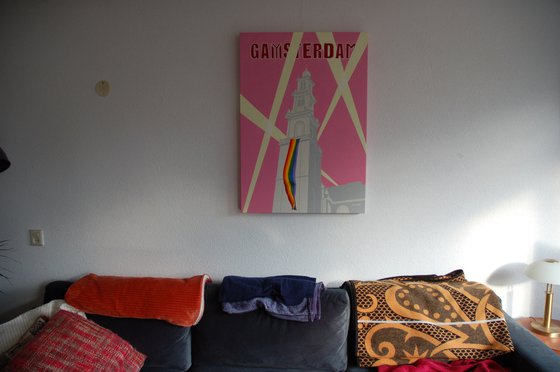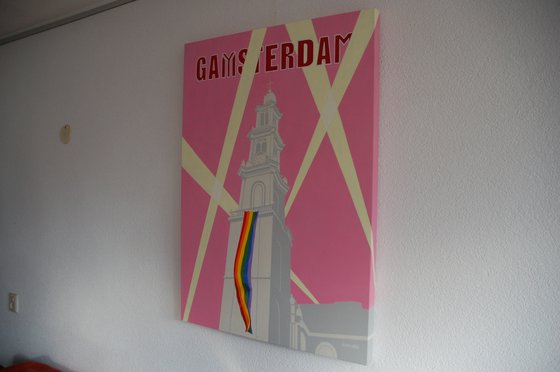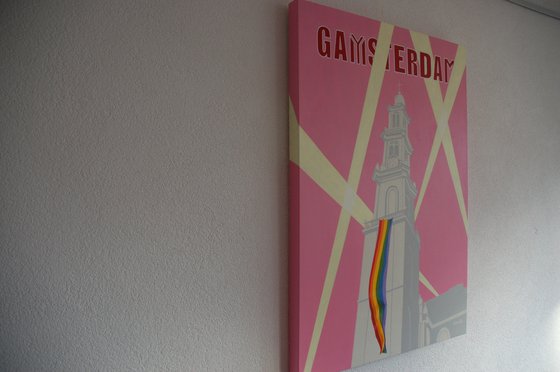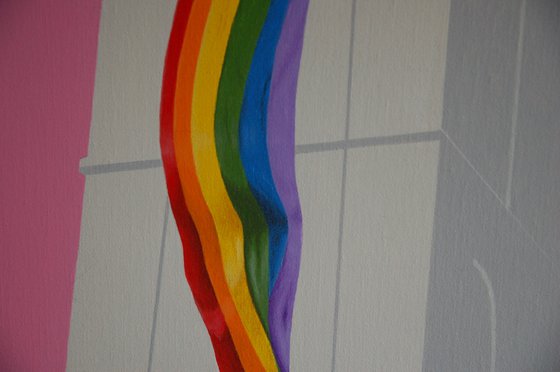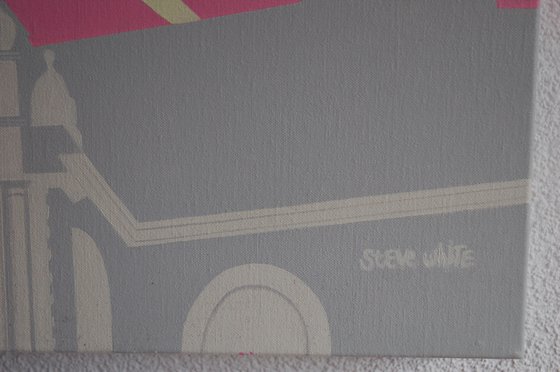- By medium
- By subject
- By budget
- Sales
- Gift cards
- Discover all art
- Artists
- Editors’ picks
- Ideas
Original artwork description:
Nine years after the seminal riots at the mafia-owned Stonewall Inn in New York City in June 1969, the incident which forced gay rights out of the closet, Harvey Milk, one of the first openly gay elected officials in the US, urged artist and gay drag queen Gilbert Baker to come up with a symbol around which the LGBT community could unite. Baker thought flags were a most powerful symbol of pride and saw a rainbow as a 'natural flag in the sky'. So far, so colorful. The Stonewall riots happened a few days after gay icon Judy Garland's death and it has been suggested that Baker may have been inspired by the Garland song "Over the Rainbow". Whatever the case, no one can deny that unlike the flags of, say, Bhutan or Malawi, Baker's paradigmatic creation for LGBTQland is one flag of the world that everyone recognises and could instantly identify if asked on University Challenge.
However, the ultimate 'rainbow' LGBTQ flag, having only six colors, is not a rainbow. And Baker's first iteration of the symbol, having eight colors, was not a rainbow either. In the Sue-nited States of America Baker had been told that the copyright on the seven colors of the rainbow was already taken, and he was reluctant to risk a law suit from God's law firm, Moses, Bulrush, Burnie and Bush (Attorneys at Law).
The 8 color version of the flag, first flown on June 25, 1978, for the San Francisco Gay Freedom Day parade, was color coded thus: pink (sexuality), red (life), orange (healing), yellow (sunlight), green (nature), blue (harmony/peace), purple/violet (spirit), turquoise (art/magic). Baker and a team of volunteers made the first flags by hand, but when they wanted to mass-produce the flag, production issues with the pink and turquoise stripes meant that they were removed and indigo was replaced by basic blue. This resulted in the contemporary six-striped flag (red, orange, yellow, green, blue, and violet).
At various times other colors have been introduced: in the 1980s a black stripe was added to represent AIDS victims; black-and-brown stripes were added to identify people of color; white-pink-blue stripes were supposed to represent transgender and queer people; and reportedly, in response to Donald Trump's election, Baker added a ninth stripe in lavender to represent imbecility, sorry, diversity. Other interesting US adaptations of the flag involve a Stars and Stripes, with the usual red and white stripes replaced with the basic six stripes of the LGBTQ flag.
Please note the LGBTQ flag is not to be confused with the current flag of Peruvian city of Cusco; or the flag used by Jewish Autonomous Oblast, situated in the Far Eastern Federal District of Russia; or the flag of Patriots of Russia political party (Russian: Патриоты России, Patrioty Rossii); or the flag flown each year near Meher Baba's samadhi (tomb-shrine) in Meherabad, India, during the week of Amartithi; or the Italian and Greek peace flags; or the flag of South Africa. When Baker decided to co-opt the rainbow for his flag, it would be fair to say, despite its raging success, originality was not paramount. So, all in all, it's pretty confusing.
As French artist Paul Cezanne put it: We live in a rainbow of chaos.
Limited Edition Prints.
Printed on William Turner Hahnemuhle fine art exhibition quality paper (310 g/m2) using Epson Ultrachrome Pro Pigments, the colours remain true to the original up to 100 years.
The image size is 43×30 cms and there is an additional 3 cms border all the way round the image (ie total size: 49×36 cms). The artist will sign and number the print in this border. The print is unframed.
Prints will leave the artists studio within 7 days, rolled in a heavy tube, accompanied by a Certificate of Authenticity and sent via track and trace
Materials used:
Acrylics
Tags:
#pink #rainbow #lgbt #amsterdam #poster art #gay art #westerkerkFeatured by our Editors:
Gay Amsterdam (2021) Acrylic painting
by Steve White
2 Artist Reviews
£644.1
- Acrylic painting on Canvas
- One of a kind artwork
- Size: 70 x 100 x 4.5cm (unframed) / 70 x 100cm (actual image size)
- Ready to hang
- Signed on the front
- Style: Urban and Pop
- Subject: Architecture and cityscapes
Loading
Original artwork description
Nine years after the seminal riots at the mafia-owned Stonewall Inn in New York City in June 1969, the incident which forced gay rights out of the closet, Harvey Milk, one of the first openly gay elected officials in the US, urged artist and gay drag queen Gilbert Baker to come up with a symbol around which the LGBT community could unite. Baker thought flags were a most powerful symbol of pride and saw a rainbow as a 'natural flag in the sky'. So far, so colorful. The Stonewall riots happened a few days after gay icon Judy Garland's death and it has been suggested that Baker may have been inspired by the Garland song "Over the Rainbow". Whatever the case, no one can deny that unlike the flags of, say, Bhutan or Malawi, Baker's paradigmatic creation for LGBTQland is one flag of the world that everyone recognises and could instantly identify if asked on University Challenge.
However, the ultimate 'rainbow' LGBTQ flag, having only six colors, is not a rainbow. And Baker's first iteration of the symbol, having eight colors, was not a rainbow either. In the Sue-nited States of America Baker had been told that the copyright on the seven colors of the rainbow was already taken, and he was reluctant to risk a law suit from God's law firm, Moses, Bulrush, Burnie and Bush (Attorneys at Law).
The 8 color version of the flag, first flown on June 25, 1978, for the San Francisco Gay Freedom Day parade, was color coded thus: pink (sexuality), red (life), orange (healing), yellow (sunlight), green (nature), blue (harmony/peace), purple/violet (spirit), turquoise (art/magic). Baker and a team of volunteers made the first flags by hand, but when they wanted to mass-produce the flag, production issues with the pink and turquoise stripes meant that they were removed and indigo was replaced by basic blue. This resulted in the contemporary six-striped flag (red, orange, yellow, green, blue, and violet).
At various times other colors have been introduced: in the 1980s a black stripe was added to represent AIDS victims; black-and-brown stripes were added to identify people of color; white-pink-blue stripes were supposed to represent transgender and queer people; and reportedly, in response to Donald Trump's election, Baker added a ninth stripe in lavender to represent imbecility, sorry, diversity. Other interesting US adaptations of the flag involve a Stars and Stripes, with the usual red and white stripes replaced with the basic six stripes of the LGBTQ flag.
Please note the LGBTQ flag is not to be confused with the current flag of Peruvian city of Cusco; or the flag used by Jewish Autonomous Oblast, situated in the Far Eastern Federal District of Russia; or the flag of Patriots of Russia political party (Russian: Патриоты России, Patrioty Rossii); or the flag flown each year near Meher Baba's samadhi (tomb-shrine) in Meherabad, India, during the week of Amartithi; or the Italian and Greek peace flags; or the flag of South Africa. When Baker decided to co-opt the rainbow for his flag, it would be fair to say, despite its raging success, originality was not paramount. So, all in all, it's pretty confusing.
As French artist Paul Cezanne put it: We live in a rainbow of chaos.
Limited Edition Prints.
Printed on William Turner Hahnemuhle fine art exhibition quality paper (310 g/m2) using Epson Ultrachrome Pro Pigments, the colours remain true to the original up to 100 years.
The image size is 43×30 cms and there is an additional 3 cms border all the way round the image (ie total size: 49×36 cms). The artist will sign and number the print in this border. The print is unframed.
Prints will leave the artists studio within 7 days, rolled in a heavy tube, accompanied by a Certificate of Authenticity and sent via track and trace
Materials used:
Acrylics
Tags:
#pink #rainbow #lgbt #amsterdam #poster art #gay art #westerkerkFeatured by our Editors:
14 day money back guaranteeLearn more

